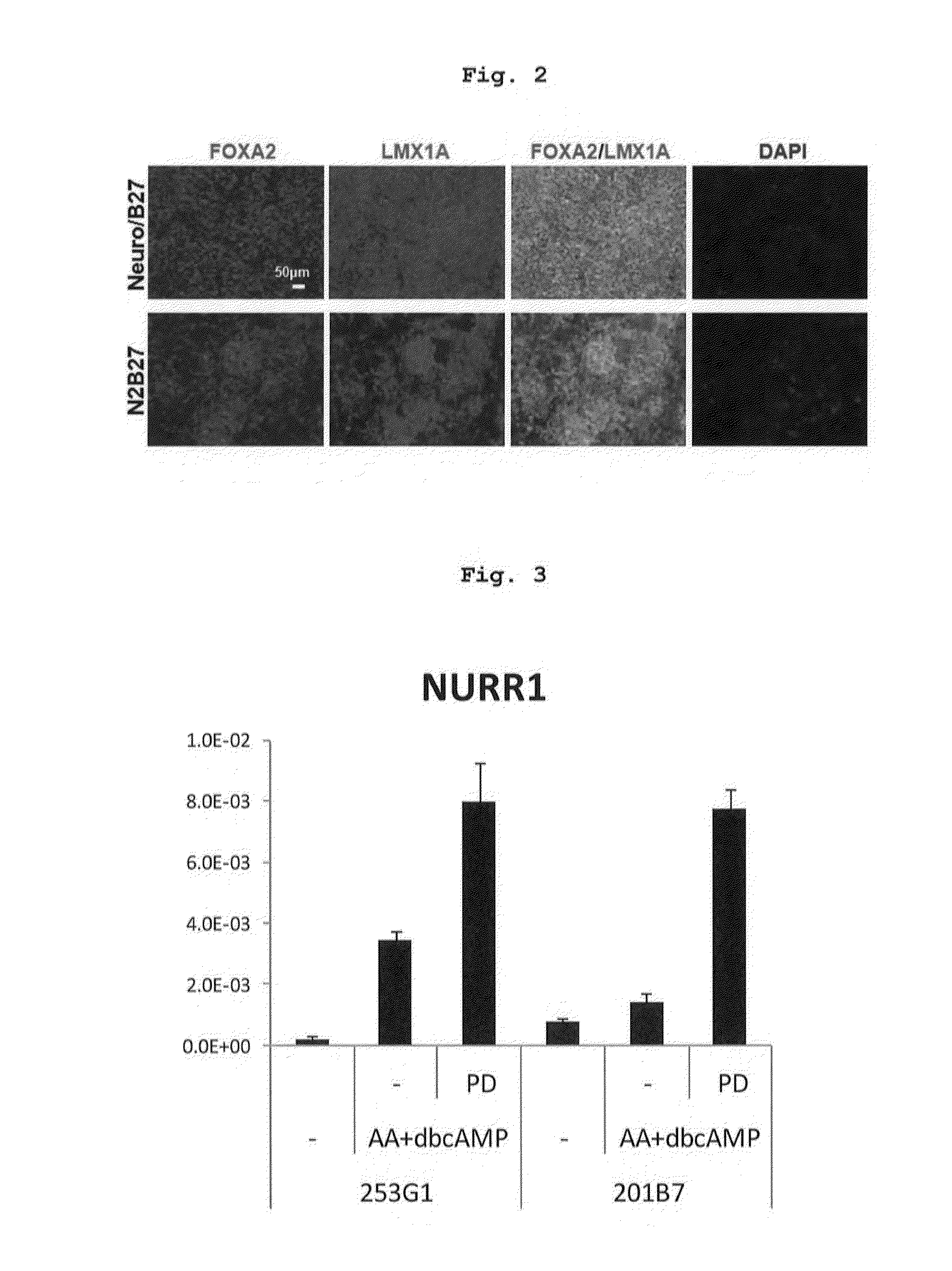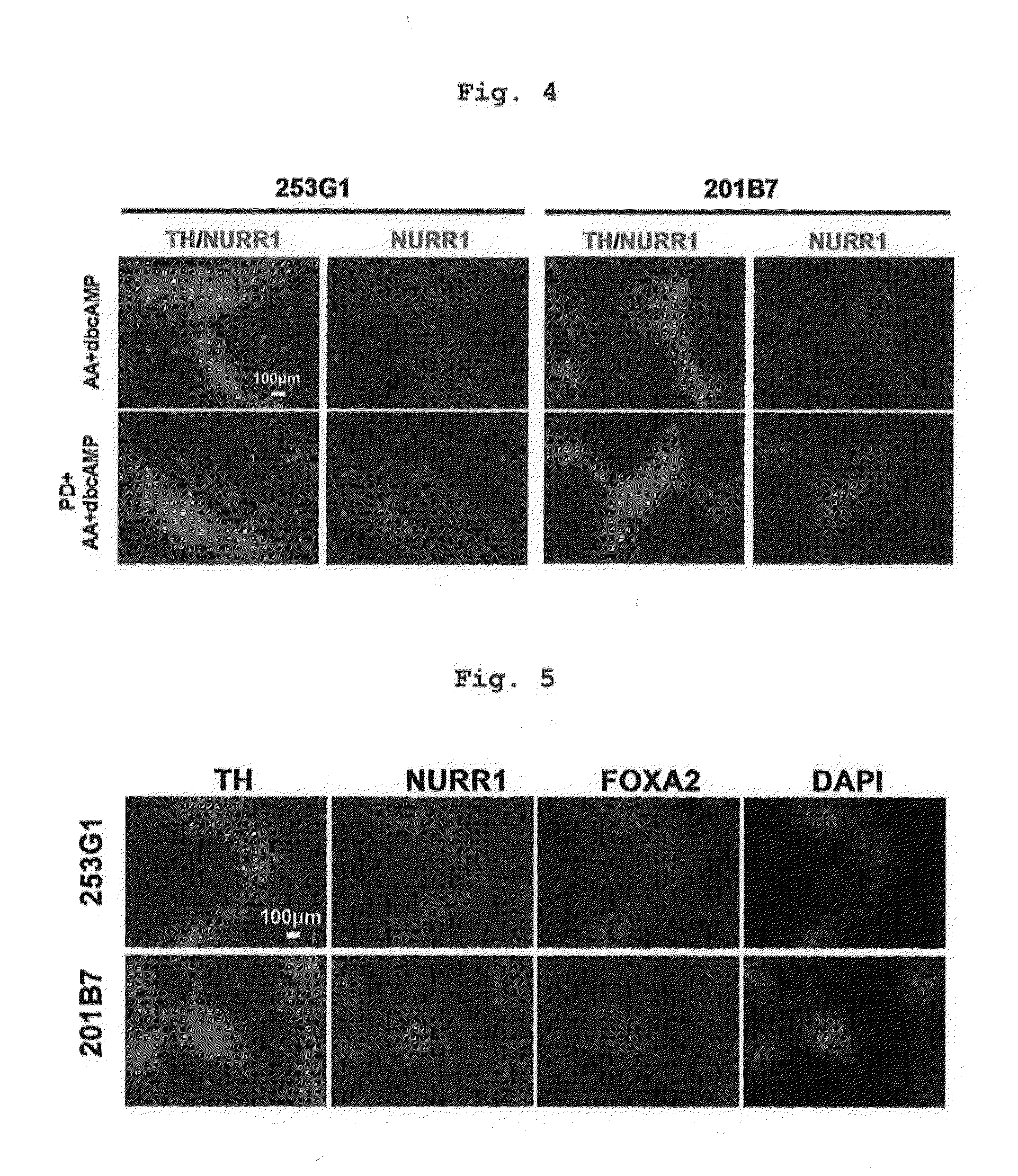Method for producing dopaminergic neurons
a production method and technology for dopaminergic neurons, applied in the direction of biocide, drug compositions, genetic material ingredients, etc., can solve the problems of low production efficiency of dopaminergic neurons obtained by these methods, insufficient functional cells, etc., and achieve high engrafted rate, high quality dopaminergic, and efficient production
- Summary
- Abstract
- Description
- Claims
- Application Information
AI Technical Summary
Benefits of technology
Problems solved by technology
Method used
Image
Examples
reference example 1
Maintenance and Culture of Undifferentiated Human iPS Cell
[0129]As human iPS cell, 253G1 strain (Nature Biotechnology 2008; 26: 101-106) or 201B7 strain (Cell. 2007; 131: 861-872) was used.
[0130]The iPS cells (253G1 strain or 201B7 strain) in an undifferentiated state were maintained and cultured in two ways by (i) a method using a feeder cell and (ii) a method without using a feeder cell.
(i) Method Using a Feeder Cell
[0131]As a feeder cell, mouse fibroblasts (MEFs, KITAYAMA LABES Co., Ltd.) which underwent a mitomycin C (Wako Pure Chemical Industries, Ltd.) treatment to inactivate the growth thereof and were seeded on a gelatin-coated plate were used. In this method, a medium for primate ES cell (ReproCELL Incorporated) added with 4 ng / ml bFGF (basic fibroblast growth factor) (PeproTech) and 0.5×Penicillin-streptomycin (Wako Pure Chemical Industries, Ltd.) was used as a medium, and the cells were cultured at 37° C. under 5% CO2. The medium was exchanged every day, and the cells wer...
reference example 2
Preculture of Human iPS Cell
[0133]For preculture of differentiation induction into a floor plate cell, undifferentiated human iPS cells maintained by culturing by the method (i) or (ii) described in the above-mentioned Reference Example 1 were seeded in a 96 well plate.
(i) When iPS Cells Maintained on Feeder Cells are Used
[0134]iPS cells maintained in the form of a cell aggregate were treated for 10 sec with a cell detachment solution for primate ES cell, and gently pipetted to remove MEFs to some extent. Then, the cells were washed with PBS, treated with Accutase (Innovative Cell Technologies) at 37° C. for 5 min, and dissociated until single cells were obtained. Then, the iPS cells dispersed in a medium were seeded in a 96 well plate at a density of 1.5-2×104 cells per well, and cultured (precultured) at 37° C. under 5% CO2 for one day. As the culture medium used for seeding, a medium for primate ES cell added with 10 μM Y27632 ((R)-(+)-trans-4-(1-aminoethyl)-N-(4-pyridyl)cyclohex...
reference example 3
Differentiation Induction from Human iPS Cell into Floor Plate Cell
[0136]Differentiation of human iPS cell into floor plate cell was induced by the following method.
[0137]The medium after preculture as described in the above-mentioned Reference Example 2 was exchanged with a differentiation induction medium containing factors inducing differentiation into floor plate cell (LDN193189 (0.5 μM, Axon MedChem B.V.), SB431542 (10 μM, Wako Pure Chemical Industries, Ltd.), purmorphamine (0.5 μM, Merck), SHH (200 ng / ml, R&D systems) and CHIR99021 (1 μM, Axon MedChem)) (day 0 of culture), and the cells were cultured at 37° C. under 5% CO2 for 5 days. Then, the medium was exchanged with a differentiation induction medium containing 0.5 μM LDN193189 and 1 μM CHIR99021, and the cells were cultured at 37° C. under 5% CO2 for 5-8 days (total 10-13 days). Here, as the above-mentioned differentiation induction medium, (a) Neurobasal (Life Technologies) containing 2% B27 (Life Technologies corporatio...
PUM
 Login to View More
Login to View More Abstract
Description
Claims
Application Information
 Login to View More
Login to View More - R&D
- Intellectual Property
- Life Sciences
- Materials
- Tech Scout
- Unparalleled Data Quality
- Higher Quality Content
- 60% Fewer Hallucinations
Browse by: Latest US Patents, China's latest patents, Technical Efficacy Thesaurus, Application Domain, Technology Topic, Popular Technical Reports.
© 2025 PatSnap. All rights reserved.Legal|Privacy policy|Modern Slavery Act Transparency Statement|Sitemap|About US| Contact US: help@patsnap.com



